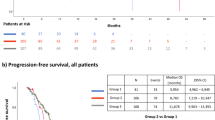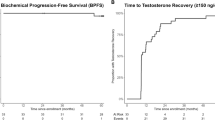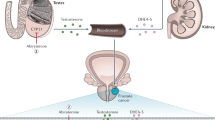Abstract
Background:
Whether adding a first-generation anti-androgen (AA) to a luteinizing hormone-releasing hormone agonist in the radiotherapeutic management of unfavorable-risk prostate cancer (PC) reduces the risk of all-cause and PC-specific mortality (ACM and PCSM) among men within differing comorbidity subgroups is unknown.
Methods:
Between 1995 and 2001, 206 men with unfavorable-risk PC were enrolled in a randomized trial comparing radiation with or without 6 months of androgen-deprivation therapy (ADT). Partial AA use (median: 4.2 months) occurred in 29 of the 102 men randomized to ADT. Cox, and Fine and Gray’s regressions were used to evaluate the impact of full versus partial AA use on PCSM and ACM-risk within comorbidity subgroups.
Results:
After a median follow-up of 16.62 years, 156 men died. In men with moderate to severe comorbidity increasing death was observed as treatment transitioned from no to partial to full ADT (P=0.02) with an increased ACM-risk with full versus partial AA use (adjusted hazard ratio (AHR), 2.25 (95% confidence interval (CI), 0.94–5.41); P=0.07); whereas only 1 and no PC deaths occurred in men receiving a partial versus full AA course, respectively. Among men with no or minimal comorbidity there was no decrease in ACM (AHR, 0.97 (95% CI, 0.49–1.91); P=0.92) or PCSM-risk (AHR 0.39 (95% CI 0.07–52.18); P=0.28) in comparing full versus partial AA use.
Conclusion:
Increasing AA use by 2 months does not appear to impact survival in men with localized unfavorable-risk PC and no or minimal comorbidity, but may shorten survival in men with moderate to severe comorbidity, raising concern regarding in whom and for how long the AA should be prescribed.
This is a preview of subscription content, access via your institution
Access options
Subscribe to this journal
Receive 4 print issues and online access
$259.00 per year
only $64.75 per issue
Buy this article
- Purchase on Springer Link
- Instant access to full article PDF
Prices may be subject to local taxes which are calculated during checkout


Similar content being viewed by others
References
Denham JW, Steigler A, Lamb DS, Joseph D, Turner S, Matthews J et al. Short term neoadjuvant androgen deprivation and radiotherapy for locally advanced prostate cancer: 10-year data from the TROG 96.01 randomised trial. Lancet Oncol 2011; 12: 451–459.
D'Amico AV, Manola J, Loffredo M, Renshaw AA, DellaCroce A, Kantoff PW et al. 6-month androgen suppression plus radiation therapy vs radiation therapy alone for patients with clinically localized prostate cancer: a randomized controlled trial. JAMA 2004; 292: 821–827.
Jones CU, Hunt D, McGowan DG, Amin MB, Chetner MP, Bruner DW et al. Radiotherapy and short-term androgen deprivation for localized prostate cancer. N Engl J Med 2011; 365: 107–118.
Bolla M, de Reijke TM, Van Tienhoven G, Van den Bergh AC, Oddens J, Poortmans PM et al. Duration of androgen suppression in the treatment of prostate cancer. N Engl J Med 2009; 360: 2516–2527.
Pilepich MV, Winter K, Lawton CA, Krisch RE, Wolkov HB, Movsas B et al. Androgen suppression adjuvant to definitive radiotherapy in prostate carcinoma—long-term results of phase III RTOG 85-31. Int J Radiat Oncol Biol Phys 2005; 61: 1285–1290.
Akaza H, Hinotsu S, Usami M, Arai Y, Kanetake H, Naito S et al. Combine androgen blockage with bicalutamide for advanced prostate cancer: long-term follow-up of a phase 3, double blind randomized study for survival. Cancer 2009; 115: 3437–3445.
D'Amico AV, Chen MH, Renshaw A, Loffredo M, Kantoff PW . Long-term follow-up of a randomized trial of radiation with or without androgen deprivation therapy for localized prostate cancer. JAMA 2015; 314: 1291–1293.
D'Amico AV, Chen MH, Renshaw AA, Loffredo B, Kantoff PW . Risk of prostate cancer recurrence in men treated with radiation alone or in conjunction with combined or less than combined androgen suppression therapy. J Clin Oncol 2008; 26: 2979–2983.
Beahrs OH, Henson DE, Hutter RVP, Kennedy BJ . American Joint Committee on Cancer: Manual for staging of cancer, 4th ed. J.B. Lippincott: Philadelphia, PA, USA, 1992.
Piccirillo JF, Tierney RM, Costas I, Grove L, Spitznagel EL Jr . Prognostic importance of comorbidity in a hospital based cancer registry. JAMA 2004; 291: 2441–2447.
Hollander M, Wolfe DA . Nonparametric Statistical Methods, 2nd ed. John Wiley & Sons, Inc.: New York, NY, USA, 1999.
Agresti A . Categorical Data Analysis, 2nd ed. John Wiley & Sons, Inc.: New York, NY, USA, 2002.
Kaplan EL, Meier P . Nonparametric estimation from incomplete observations. J Am Stat Assoc 1958; 53: 457–481.
Cox DR . Regression models and life tables (with discussion). J R Stat Soc B 1972; 34: 187–220.
Fine JP, Gray RJ . A proportional hazards model for the subdistribution of a competing risk. J Am Stat Assoc 1999; 94: 496–509.
Klein JP, Moeschberger ML . Survival Analysis: Techniques for Censored and Truncated Data, 2nd ed. Springer: New York, NY, USA, 2003.
Gaynor JJ, Feuer EJ, Tan CC, Wu DH, Little CR, Straus DJ et al. On the use of cause-specific failure and conditional failure probabilities: examples from clinical oncology data. J Am Stat Assoc 1993; 88: 400–409.
Cupples LA, Gagnon DR, Ramaswamy R, D'Agostino RB . Age-adjusted survival curves with application in the Framingham Study. Stat Med 1995; 14: 1731–1744.
Penson DF, Armstrong AJ, Concepcion R, Agarwal N, Olsson C, Karsh L et al. Enzalutamide versus bicalutamide in castration-resistant prostate cancer: The STRIVE Trial. J Clin Oncol 2016; 34: 2096–2106.
Denham JW, Steigler A, Lamb DS, Joseph D, Turner S, Matthews J et al. Short-term neoadjuvant androgen deprivation and radiotherapy for locally advanced prostate cancer: 10-year data from the TROG 96.01 randomised trial. Lancet Oncol 2011; 12: 451–459.
Author information
Authors and Affiliations
Corresponding author
Ethics declarations
Competing interests
The authors declare no conflict of interest.
Additional information
Author contributions
M-HC had full access to all data in the study. NNS, M-HC and AVD’A take responsibility for the integrity of the data and the accuracy of the data analysis.
Rights and permissions
About this article
Cite this article
Sanford, N., Chen, MH., Loffredo, M. et al. Duration of the anti-androgen in men undergoing 6 months of an LHRH agonist and radiation therapy for unfavorable-risk prostate cancer and the risk of death. Prostate Cancer Prostatic Dis 20, 79–84 (2017). https://doi.org/10.1038/pcan.2016.53
Received:
Revised:
Accepted:
Published:
Issue Date:
DOI: https://doi.org/10.1038/pcan.2016.53



